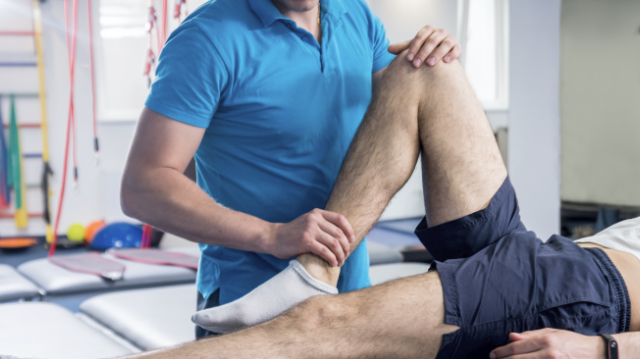
As we described in our first post, knee osteoarthritis is a disorder that involves the cartilage in a knee joint. In a normal knee, the ends of each bone are covered by cartilage, a smooth substance that protects the bones from one another and absorbs shock during impact. In knee osteoarthritis, this cartilage becomes stiff and loses its elasticity, which makes it more vulnerable to damage. Cartilage may begin to wear away over time, which greatly reduces its ability to absorb shock and increases the chances that bones will touch one another. When this occurs, it typically leads to pain within and around the knee that gets worse with activities like walking, going up/down stairs, or sitting/standing, as well as swelling, tenderness, and stiffness.
Although no treatment can slow or stop this loss of cartilage, physical therapy is strongly recommended as an initial intervention for all cases of knee osteoarthritis. Undergoing a course of physical therapy can help reduce pain levels and preserve knee function through movement-based strategies like stretching and strengthening exercises, hands-on therapy, bracing, and recommendations on how to modify bothersome activities.
But many patients with knee osteoarthritis still wind up needing to have their knee joint replaced surgically with a total knee arthroplasty (TKA) at some point in the future. These patients usually fail to improve to an adequate degree with physical therapy and other non-surgical interventions. In addition, mostâor allâof the protective cartilage surrounding the ends of the bones has completely worn away. This results in bone rubbing against bone when the knee moves, which is extremely painful and makes walking and other movements extremely challenging. Prior to surgery, however, some patients are referred to physical therapy for a preoperative treatment program, which is intended to improve outcomes after surgery.
Below, we describe the findings of two recent studies that highlight how physical therapy is effective both for patients with active knee osteoarthritis and for those who are preparing to have a TKA for their damaged knee:
Study #1
In the first study, published in 2021, 40 patients with knee osteoarthritis were randomly assigned to either the exercise group or the control group. Participants in the exercise group completed an exercise program that included three 50-minute treatment sessions per week for six weeks. These patients completed two sets of exercises that were intended to strengthen the quadriceps muscles of the thigh. Participants in control group received 10 minutes of infrared therapy to the knee without any other interventions and were otherwise advised to continue with their daily activities. All patients were assessed for pain, range of motion, and several other outcomes before beginning treatment and immediately afterwards.
Results showed that patients in the exercise group experienced significantly greater improvements in pain, stiffness, physical function, and passive and active range of motion. Therefore, it appears that participating in an exercise therapy program can lead to notable gains that will likely improve quality of life for patients with knee osteoarthritis.
Study #2
The other study was a 2021 systematic review and meta-analysis in which researchers performed a comprehensive search of five medical databases to identify trials that evaluated the effectiveness of participating in an exercise therapy program prior to undergoing a TKA. This search led to 12 studies fitting the necessary inclusion criteria, which included data on 889 patients who were evaluated at regular intervals for up to 12 weeks after surgery.
According to results, patients who underwent the preoperative exercise intervention had more knee flexibility at 6â12 weeks after surgery, stronger quadriceps muscles, better scores on an arthritis-specific test, and greater quality of life scores compared to patients in the control group. This suggests that preoperative exercises can lead to major improvements in the early rehabilitation period after surgery.
We hope these recent studies have provided you with an even better understanding of the various benefits of physical therapy for patients with knee and thigh pain. And if youâre currently bothered by pain in these regions or anywhere else in the body, we invite you to come in for a visit so we can determine the cause and get you started on path to recovery right away.
